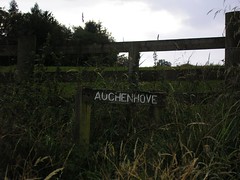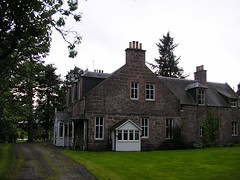Our first foray into my family history was to look in the Lumphanan kirkyard to find the grave of Mary Sherrat. (She was the daughter of Robert and Isobel, and the one who keep the family line going in Scotland, while other siblings emigrated to Canada.) After a morning of whisky-tasting and an afternoon touring Castle Fraser, we followed increasingly narrow country roads to get us across to Lumphanan. After finding the church (which we could see up on a hill, but had a little trouble figuring out how to get to it), we wandered among the graves, arranged along terraced berms in the steeply sloping kirkyard around the side and back of the church. Alas, we could not find Mary anywhere. I know the stone is there, but unfortunately, I was not as organized as I should have been, and didn't have a map of the kirkyard (one is available from the good folks at the Aberdeen & Northeast Scotland Family History Society) identifying the stone. Shame on me. None the less, it was still neat to see this kirkyard and this small village which looks quite untouched by time.
As we headed home, I had one other stop in mind, which turned out to be much more rewarding. Isobel's sister Christian had married an aging laird who owned 8000 acres in Birse parish, and an equal amount in Lumphanan. Later in life, when she was a widow and her son the new laird was grown, she was given a place called Auchinhove Cottage to live out her years. (She lived at Auchinhove Cottage from 1823 until her death in 1849 at age 80.) Christian's niece Mary Sherrat (whose grave we couldn't find) lived with her or very nearby during that time, and Auchinhove was farmed by Mary's son Robert Cromar as late as 1901.
 I knew from present-day maps that there was still some place called Auchinhove, and it was on our way back to Aboyne, albeit along a small country road. Just where the map said it would be, I was delighted to find a gate with a wooden sign on it saying "Auchenhove". (The spelling has wavered between an 'e' and an 'i' in the second syllable, but when doing genealogy you learn not to be overly distinguishing about spelling). The gate was open, so we followed a dirt and gravel driveway a small distance until we came upon Auchenhove Cottage, an old 2-story stone house a good bit larger than we Americans would expect to find called a "cottage". We pulled up around back where there was a place to park, and I walked around front and gingerly knocked on the door. After a couple of knocks, a woman answered the door and I asked if this was Auchinhove Cottage, and explained that my 5x-great-aunt had lived here 170 years ago. She was quite nice and we chatted for a bit. She explained that she was a relative newcomer, moved up here from England a few years ago. She didn't think the present house was as old as my aunt's time, but was probably later Victorian. She also told us that while she had only been here a few years, the older couple that she bought the place from had lived on it for a very long time, and they had retired to the smaller "gardener's cottage" of the estate, just a couple minutes away. She made a quick phone call for us, and told us that Mrs. Allen would be expecting us. (In chatting, we also discovered among other things that she worked as a docent at Crathes Castle, and sure enough we ran into her there the next day.)
I knew from present-day maps that there was still some place called Auchinhove, and it was on our way back to Aboyne, albeit along a small country road. Just where the map said it would be, I was delighted to find a gate with a wooden sign on it saying "Auchenhove". (The spelling has wavered between an 'e' and an 'i' in the second syllable, but when doing genealogy you learn not to be overly distinguishing about spelling). The gate was open, so we followed a dirt and gravel driveway a small distance until we came upon Auchenhove Cottage, an old 2-story stone house a good bit larger than we Americans would expect to find called a "cottage". We pulled up around back where there was a place to park, and I walked around front and gingerly knocked on the door. After a couple of knocks, a woman answered the door and I asked if this was Auchinhove Cottage, and explained that my 5x-great-aunt had lived here 170 years ago. She was quite nice and we chatted for a bit. She explained that she was a relative newcomer, moved up here from England a few years ago. She didn't think the present house was as old as my aunt's time, but was probably later Victorian. She also told us that while she had only been here a few years, the older couple that she bought the place from had lived on it for a very long time, and they had retired to the smaller "gardener's cottage" of the estate, just a couple minutes away. She made a quick phone call for us, and told us that Mrs. Allen would be expecting us. (In chatting, we also discovered among other things that she worked as a docent at Crathes Castle, and sure enough we ran into her there the next day.) We hopped in the car and went partway back out the drive to where it forked, and then followed that back to the single-story Gardener's Cottage and found Mrs. Allen. She did know a good bit about the history of the place, and knew that Auchinhove had been the "dower house" for the widow of a Finzean laird. While Auchinhove had once been a farm of some size, over the years it had been divided up and sold off, and the main house now has just a few acres, no longer a farm. But the most exciting thing was this: She said that the first woman was mistaken about the age of the house, and that it was still the same "dower house", although it had had some additions and alterations as most houses of that age do. So we had indeed seen the house that my 5x-great-aunt had lived in. It is so amazing to have studied my family history on paper (and microfilm and web pages), and then to actually see the very house lived in by my ancestors of six generations ago.
We hopped in the car and went partway back out the drive to where it forked, and then followed that back to the single-story Gardener's Cottage and found Mrs. Allen. She did know a good bit about the history of the place, and knew that Auchinhove had been the "dower house" for the widow of a Finzean laird. While Auchinhove had once been a farm of some size, over the years it had been divided up and sold off, and the main house now has just a few acres, no longer a farm. But the most exciting thing was this: She said that the first woman was mistaken about the age of the house, and that it was still the same "dower house", although it had had some additions and alterations as most houses of that age do. So we had indeed seen the house that my 5x-great-aunt had lived in. It is so amazing to have studied my family history on paper (and microfilm and web pages), and then to actually see the very house lived in by my ancestors of six generations ago.
1 comment:
Hi,
just to say that we're related. My mum was a Cromar. It's been great finding out about where the family used to live, and where most of their graves are.
best wishes
Kathy
Post a Comment